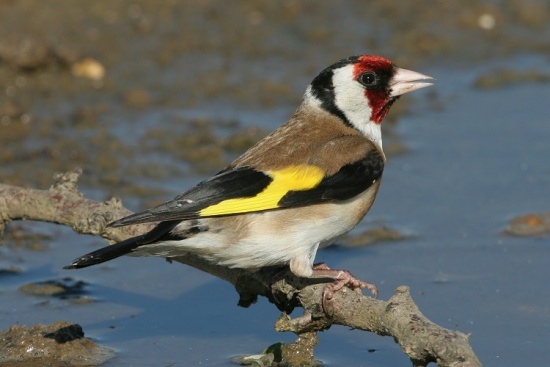m |
BigRedBirder (talk | contribs) |
||
| Line 3: | Line 3: | ||
==Identification== | ==Identification== | ||
| − | + | L. 12-13 cm<br/> | |
| + | W. 21-25 cm<br/> | ||
| + | Weight of 14 to 19 grams<br/> | ||
| + | Sexes similar | ||
| + | *Red face, | ||
| + | *Black and white head, | ||
| + | *Warm brown upperparts, | ||
| + | *White underparts with buff flanks and breast patches, and | ||
| + | *Black and yellow wings. | ||
| + | *Ivory bill | ||
| + | *Forked tail | ||
| + | ====Juveniles==== | ||
| + | *Plain head | ||
| + | *Greyer back | ||
| + | *Unmistakable due to the yellow wing stripe. | ||
| + | |||
| + | On closer inspection male Goldfinches can often be distinguished by a larger red mask that spreads just beyond the eye.<br/> | ||
| + | Birds in central Asia (''caniceps'' group) have a plain grey head behind the red face, lacking the black and white head pattern of European and western Asian birds. | ||
==Distribution== | ==Distribution== | ||
It breeds across Europe, north Africa, and western and central Asia, in open, partially wooded lowlands. It is resident in the milder west of its range, but migrates from colder regions. It will also make local movements, even in the west, to escape bad weather. It has been introduced to many areas of the world (Snow and Perrins 1998). | It breeds across Europe, north Africa, and western and central Asia, in open, partially wooded lowlands. It is resident in the milder west of its range, but migrates from colder regions. It will also make local movements, even in the west, to escape bad weather. It has been introduced to many areas of the world (Snow and Perrins 1998). | ||
==Taxonomy== | ==Taxonomy== | ||
| − | The species is divided into two major groups, each comprising several races. The two groups intergrade at their boundary, so the caniceps group is not recognised as a distinct species despite its readily distinguishable plumage. | + | The species is divided into two major groups, each comprising several races. The two groups intergrade at their boundary, so the ''caniceps'' group is not recognised as a distinct species despite its readily distinguishable plumage. |
==Habitat== | ==Habitat== | ||
Weedy fields, gardens | Weedy fields, gardens | ||
==Behaviour== | ==Behaviour== | ||
| − | The food is small seeds such as thistles (the Latin name is from carduus, thistle) and teasels, but insects are also taken when feeding young. It also regularly visits bird feeders in winter. They nest in the outer twigs of tall leafy trees, laying four to six eggs which hatch in 11-14 days. | + | ====Diet==== |
| + | The food is small seeds such as thistles (the Latin name is from carduus, thistle) and teasels, but insects are also taken when feeding young. It also regularly visits bird feeders in winter. | ||
| + | ====Breeding==== | ||
| + | They nest in the outer twigs of tall leafy trees, laying four to six eggs which hatch in 11-14 days. | ||
In the winter they group together to form flocks of up to about 40 birds | In the winter they group together to form flocks of up to about 40 birds | ||
Revision as of 17:24, 28 December 2007
- Carduelis carduelis
Identification
L. 12-13 cm
W. 21-25 cm
Weight of 14 to 19 grams
Sexes similar
- Red face,
- Black and white head,
- Warm brown upperparts,
- White underparts with buff flanks and breast patches, and
- Black and yellow wings.
- Ivory bill
- Forked tail
Juveniles
- Plain head
- Greyer back
- Unmistakable due to the yellow wing stripe.
On closer inspection male Goldfinches can often be distinguished by a larger red mask that spreads just beyond the eye.
Birds in central Asia (caniceps group) have a plain grey head behind the red face, lacking the black and white head pattern of European and western Asian birds.
Distribution
It breeds across Europe, north Africa, and western and central Asia, in open, partially wooded lowlands. It is resident in the milder west of its range, but migrates from colder regions. It will also make local movements, even in the west, to escape bad weather. It has been introduced to many areas of the world (Snow and Perrins 1998).
Taxonomy
The species is divided into two major groups, each comprising several races. The two groups intergrade at their boundary, so the caniceps group is not recognised as a distinct species despite its readily distinguishable plumage.
Habitat
Weedy fields, gardens
Behaviour
Diet
The food is small seeds such as thistles (the Latin name is from carduus, thistle) and teasels, but insects are also taken when feeding young. It also regularly visits bird feeders in winter.
Breeding
They nest in the outer twigs of tall leafy trees, laying four to six eggs which hatch in 11-14 days.
In the winter they group together to form flocks of up to about 40 birds
Bird Song
<flashmp3>Carduelis carduelis (song).mp3</flashmp3>
Listen in an external program




